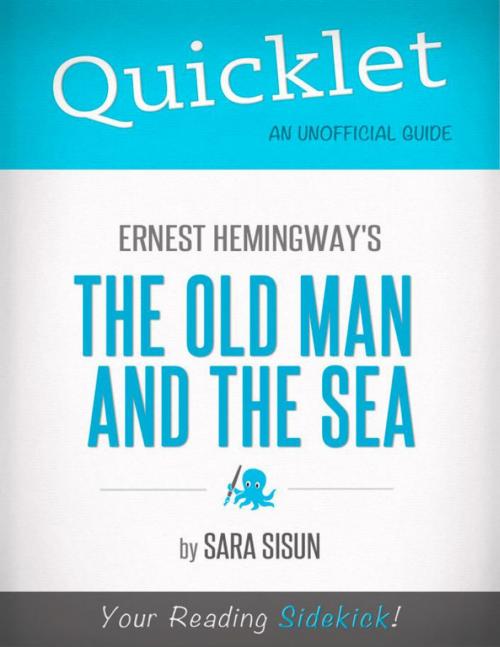Quicklet on Ernest Hemingway's The Old Man and the Sea (CliffsNotes-like Summary, Analysis, and Commentary)
Nonfiction, Reference & Language, Study Aids, Book Notes, Art & Architecture, General Art| Author: | Mandy Howard | ISBN: | 9781614648260 |
| Publisher: | Hyperink | Publication: | March 4, 2012 |
| Imprint: | Hyperink | Language: | English |
| Author: | Mandy Howard |
| ISBN: | 9781614648260 |
| Publisher: | Hyperink |
| Publication: | March 4, 2012 |
| Imprint: | Hyperink |
| Language: | English |
Quicklets: Your Reading Sidekick!
ABOUT THE BOOK
Everything about him was old except his eyes and they were the same color as the sea and were cheerful and undefeated.
The Old Man and the Sea is one of the most recognized titles in the American canon, the simple story of a man named Santiago, who has acquired iconic status for his encounter with the ultimate catch in the Atlantic ocean. The novel addresses themes common to many of Hemingways novels: identity, manhood, death, and religion. His straightforward confrontation of these issues, central to the American experience, gives a contemporary relevance to the novel. Hemingway wrote The Old Man and the Sea in 1952 while in Cuba, the last book he published during his lifetime. The book is largely responsible for Hemingways celebrity, and was extremely successful before he died.
The novel likely began as a story written for Esquire magazine in 1936 about a fisherman at sea, attacked by sharks while chasing a giant catch. The success of this story led him to expand it into a short novel. Hemingway published Across the River and Into the Trees in 1952, though it was met with great disappointment. Many doubted that the author had another great novel in him. Hemingway was concerned, as it was important to him that The Old Man and the Sea become a literary success.
MEET THE AUTHOR
Sara Sisun is a writer and painter born in Denver, Colorado. She received a BA in Art and Writing at Stanford University in 2009 and an MFA at the San Francisco Art Institute in 2011. She has studied at the Art Students League of Denver, the Slade School of Art, and Oxford University. She is the recipient of the Allied Arts Award, the New York Art Exchange Scholarship, and the Elizabeth Greenshields Fellowship. Sara currently teaches, writes, and paints in San Francisco, California.
EXCERPT FROM THE BOOK
He realizes that this fish is very, very large. He prays that he will be able to manage it, and that his hand will uncramp. As he drifts further out, and with nothing to occupy his time, he begins to wishes that he could fall asleep and dream about the lions because they are the only thing left. He misses getting to read the baseball scores, and he compares himself in his mind to the great DiMaggio, who plays with a bone spur in his heel, just as he is fishing with a cramped arm.
The old man catches glimpses of the fish and knows that he is huge. He feels as though he is starting to lose his senses, and fervently hopes that the fish dies and not him. He reminds himself again and again to keep a clear head. As the fish pulls close to the boat, the old man grabs his harpoon and spears him as hard as he can. He drives the harpoon deeply into the fishs chest, he sense that the fish, has his death in him. The fish dies, floating to the surface of the ocean. The old man thinks the fish must be at least fifteen hundred pounds. Its eyes are as detached as a saints.
The old man is running out of food and water, so he runs the line through the giant fishs gills and begins to tow him home. But as they are on their way when the old man becomes aware of a shark alongside the boat. The shark lunges for the fish, taking a chunk out of it for lunch; When the fish is mutilated, the old man feels as though he has been mutilated. The old man guesses he has lost about forty pounds of fish from the blow, and that other sharks will be coming...
Buy a copy to keep reading!
CHAPTER OUTLINE
Quicklet On Ernest Hemingway’s The Old Man and the Sea
+ About the Novel
+ About the Author
+ Overall Plot Summary
+ Summary and Analysis
+ ...and much more
Quicklets: Your Reading Sidekick!
ABOUT THE BOOK
Everything about him was old except his eyes and they were the same color as the sea and were cheerful and undefeated.
The Old Man and the Sea is one of the most recognized titles in the American canon, the simple story of a man named Santiago, who has acquired iconic status for his encounter with the ultimate catch in the Atlantic ocean. The novel addresses themes common to many of Hemingways novels: identity, manhood, death, and religion. His straightforward confrontation of these issues, central to the American experience, gives a contemporary relevance to the novel. Hemingway wrote The Old Man and the Sea in 1952 while in Cuba, the last book he published during his lifetime. The book is largely responsible for Hemingways celebrity, and was extremely successful before he died.
The novel likely began as a story written for Esquire magazine in 1936 about a fisherman at sea, attacked by sharks while chasing a giant catch. The success of this story led him to expand it into a short novel. Hemingway published Across the River and Into the Trees in 1952, though it was met with great disappointment. Many doubted that the author had another great novel in him. Hemingway was concerned, as it was important to him that The Old Man and the Sea become a literary success.
MEET THE AUTHOR
Sara Sisun is a writer and painter born in Denver, Colorado. She received a BA in Art and Writing at Stanford University in 2009 and an MFA at the San Francisco Art Institute in 2011. She has studied at the Art Students League of Denver, the Slade School of Art, and Oxford University. She is the recipient of the Allied Arts Award, the New York Art Exchange Scholarship, and the Elizabeth Greenshields Fellowship. Sara currently teaches, writes, and paints in San Francisco, California.
EXCERPT FROM THE BOOK
He realizes that this fish is very, very large. He prays that he will be able to manage it, and that his hand will uncramp. As he drifts further out, and with nothing to occupy his time, he begins to wishes that he could fall asleep and dream about the lions because they are the only thing left. He misses getting to read the baseball scores, and he compares himself in his mind to the great DiMaggio, who plays with a bone spur in his heel, just as he is fishing with a cramped arm.
The old man catches glimpses of the fish and knows that he is huge. He feels as though he is starting to lose his senses, and fervently hopes that the fish dies and not him. He reminds himself again and again to keep a clear head. As the fish pulls close to the boat, the old man grabs his harpoon and spears him as hard as he can. He drives the harpoon deeply into the fishs chest, he sense that the fish, has his death in him. The fish dies, floating to the surface of the ocean. The old man thinks the fish must be at least fifteen hundred pounds. Its eyes are as detached as a saints.
The old man is running out of food and water, so he runs the line through the giant fishs gills and begins to tow him home. But as they are on their way when the old man becomes aware of a shark alongside the boat. The shark lunges for the fish, taking a chunk out of it for lunch; When the fish is mutilated, the old man feels as though he has been mutilated. The old man guesses he has lost about forty pounds of fish from the blow, and that other sharks will be coming...
Buy a copy to keep reading!
CHAPTER OUTLINE
Quicklet On Ernest Hemingway’s The Old Man and the Sea
+ About the Novel
+ About the Author
+ Overall Plot Summary
+ Summary and Analysis
+ ...and much more















